Japanese Design Archive Survey
DESIGN ARCHIVE
Designers & Creators
Eiko Ishioka
Art director, Designer
Date: 23 February 2023, 14:00-16:00
Location: Ryoko Ishioka Design Office
Interviewee: Ryoko Ishioka
Interviewer: Keiko Kubota, Yasuko Seki
Author: Yasuko Seki
PROFILE
Profile
Eiko Ishioka
Designers, Creators
1938 Born in Tokyo
1957 Entered Tokyo University of the Arts, Department of Crafts, Design Planning
1961 Joined Shiseido Advertising Department
1963 Awarded a special prize at the 13th Japan Advertising Artists Club
1965 Awarded the highest prize at the 15th Japan Advertising Artists Club (first time woman to win this prize).
1968 Resigned from Shiseido
1970 Established Eiko Ishioka Design Office
1971 Participates in the total direction of Shibuya Parco
1980 Moves to New York
1983 " EIKO by EIKO" published, Callaway Editions(NY)
1993 Received the 65th Academy Award for Best Costume Design for the film "Bram Stoker’s Dracula"
2002 Received the Medal with Purple Ribbon.
2005 Autobiography "I DESGIN", Kodansha
2008 Costume direction for the opening ceremony of the Beijing Olympics
2012 Pass away

Description
Description
In 2006, I interviewed Eiko Ishioka for a book entitled 'AERA DESIGN: The Masters Who Designed Nippon' published by the Asahi Shimbun. The Asahi staff and I waited nervously in a hotel room in Tokyo, and Ms Ishioka turned up on time. We were overwhelmed by the aura she emitted. I remember that the interview lasted about two hours. She answered all our questions straightforwardly and frankly, and I lost track of time.
In 2005, the year before this interview, Ms Ishioka had published a book titled "I DESIGN", which she had written herself about her activities and personal life after moving to New York. Of course, I had read the book before going to the interview. In that interview, she also talked about her work and the design world at that time, going back to the 1960s and 1970s, which was not mentioned in the book.
In the opening of the article, I wrote: "Eiko Ishioka is a global person who speaks a universal language called 'design', and her ideas and originality in the 1970s easily transcended not only national borders and cultural spheres, but also gender and age barriers". Ten years after her death, I would like to add that her works and activities also transcend time - they are Timeless. In 2020, eight years after her death, two major exhibitions were held almost simultaneously at the Museum of Contemporary Art Tokyo and ginza graphic gallery (in 2021, the exhibition travelled to Kyoto ddd gallery). Behind the scenes was Ryoko Ishioka, herself a graphic designer and Eiko's younger sister. In conjunction with the exhibition, " EIKO ISHIOKA:A JOURNEY TO FIND NEVER SEEN BEFORE " by Koichi Kawajiri and the exhibition catalogue “Eiko Ishioka: Blood, Sweat and Tears - A Life of Design" were also published. Through the exhibitions and the books, Ishioka's overwhelming human power and dense work capacity were re-acknowledged.
For this issue, we interviewed Eiko Ishioka's sister and graphic designer Ryoko Ishioka, Eishi Kitazawa of the DNP Foundation for Cultural Promotion (who retired in April 2023), who was a curator at the ggg, as well as Takako Morizaki and Aya Tanaka of the foundation, about Eiko Ishioka's design and her archive.
Masterpiece
Major works
Graphic works
Magazine Advertisement ‘Shiseido Honey Cake’, Shiseido (1964)
Poster 'Symposium: Discovery of Today No.1~9 ', (1965) Awarded the highest prize at the JAAC.
Poster ‘Shiseido Beauty Cake’, Shiseido (1966)
Poster 'NEW MUSIC MEDIA' (1974)
Magazine cover “Yasei-Jidai (Wild Times)", Kadokawa Shoten (1974-78).
Poster 'A Models is Just More Than a Pretty Face', Parco (1975)
Poster ’Ah, Our Roots!’, Parco (1977)
Poster "Apocalypse Now (Japanese version)" (1979)
Poster ‘Can West Wear East?’, Parco (1979)
Binding "NUBA by Leni Riefenstahl", Parco Publishing (1980)
Package Design "Yamamoto Nori", Yamamoto Noriten (1981)
Book Design “Eiko by Eiko: Eiko Ishioka, Japan’s Ultimate Designer" Callaway Editions (English edition), Kyuryudo Art-Publishing (Japanese edition) (1983).
Record Jacket Design "Miles Davis: TUTU (US edition)" (1986)
Corporate Identity Design, Tokyu Department Store (1989)
Poster ‘Q Version 1.’,Tokyu Department Store (1989)
Exhibitions
'LENI Riefenstahl: LIFE ', Venue: The Bunkamura Museum of Art (1991)
Film, Theatre
Production Design for Film 'MISHIMA - A LIFE IN FOUR CHAPTERS' (1984)
Costume Design for Film "Bram Stoker’s Dracula" (1992)
Costume Design for Opera “The Ring of Nibelung” (1997)
Costume Design for Film “The Cell” (1999)
Directed the Music video “björk: Cocoon” (2001)
Wear Design for Salt Lake City Winter Olympics
Canada, Switzerland, Spain, Japan Team (2001)
Costume Design for Cirque du Soleil 'Varekai' (2002)
Costume Design for Beijing Olympics Opening Ceremony (2008)
Costume Design for the Broadway Musical “Spider-Man” (2011)
Costume Design for film “Mirror Mirror” (2012)
Books
Book Design “Eiko by Eiko: Eiko Ishioka, Japan’s Ultimate Designer" Callaway Editions, NY (English edition), Kyuryudo Art-Publishing (Japanese edition) (1983).
“LENI RIEFENSTAHL: LIFE” Kyuryudo Art-Publishing (1992)
“EIKO on STAGE”, Callaway Editions, U.S. (2000)
"I DESGIN", Kodansha (2005)
“ggg Books 68: Eiko Ishioka”, ginza graphic gallery (2005)
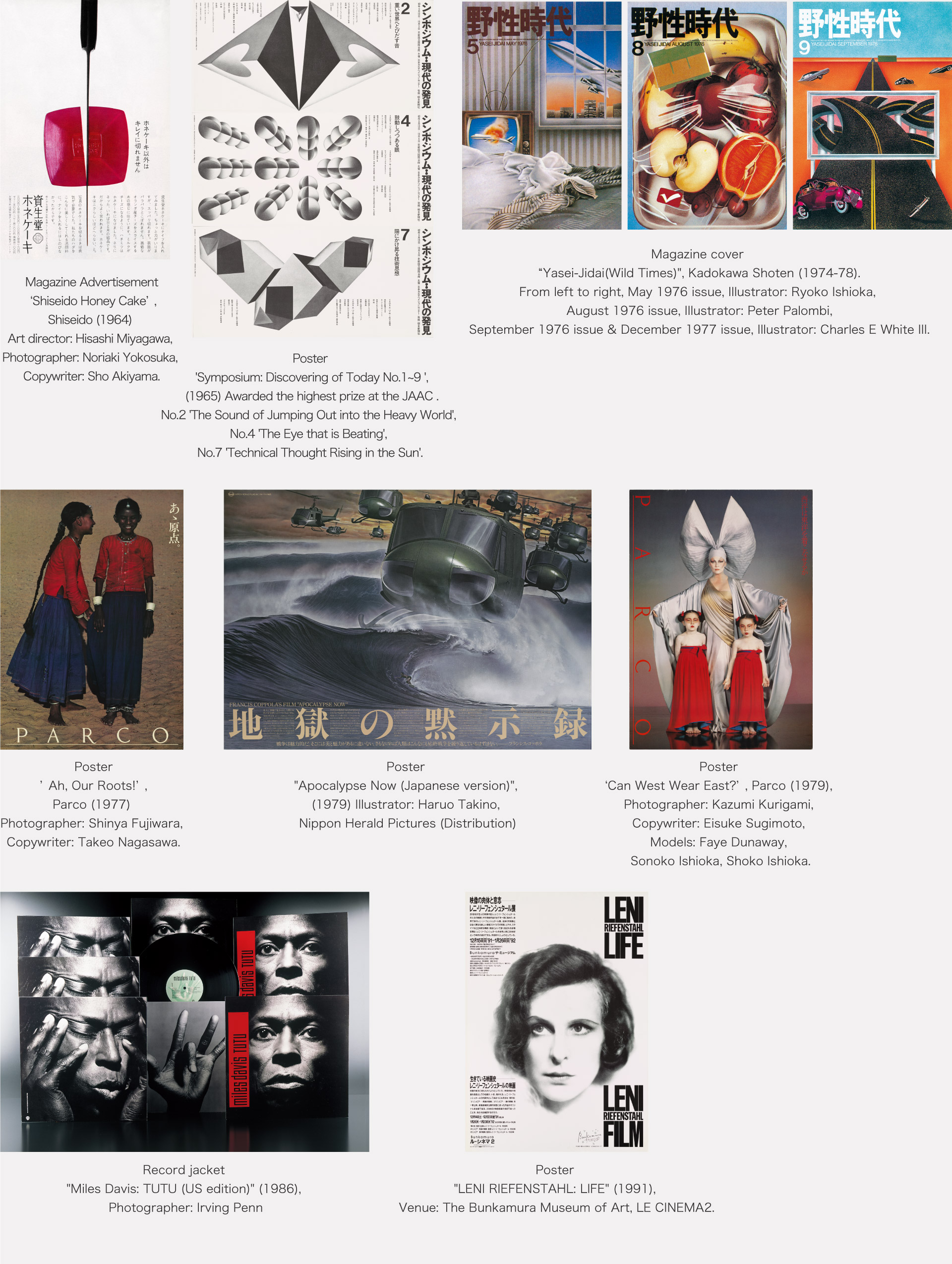
Interview 1
Interview 01
Eiko, when starting a new job, would always started with a blank canvas.
Eiko Ishioka's archive now.
In autumn 2020, the Museum of Contemporary Art Tokyo (hereafter MOT) and the ginza graphic gallery (hereafter ggg) were filled with the enthusiasm of the many works by Eiko Ishioka and the many visitors. It was the first retrospective exhibition of Eiko Ishioka's work, eight years after her death.
In 1980, Eiko Ishioka easily abandoned her glorious career in Japan and moved to New York. Since then, she has worked in Hollywood films, on Broadway, in European opera houses and with world-famous artists, traversing the globe with the flexibility that is characteristic of a woman.
In 2008, the name of creator ‘EIKO ISHIOKA’ must have been etched in the memories of hundreds of millions of people, along with her gorgeous and elaborate costumes for the opening ceremony of the Beijing Olympics, which was directed by Zhang Yimou (film director).
Four years later, in 2012, the news of her death from pancreatic cancer came as a shock. She was 73 years, and her death was untimely. What is the status of her valuable works and materials?
ー I have heard that Eiko Ishioka's works and materials are currently in Japan and the USA, but what is the current situation? How is Eiko’s sister, Ryoko, involved in the project?
Ishioka Before she passed away, my sister contacted me to help her organise her things as she was going back to Japan temporarily. Unlike me, my sister is someone who keeps everything and is a perfectionist. I did not willingly agree, as I would not be able to do my own work if I got caught up in her pace. However, she died of illness shortly afterwards, and I decided that I had to do something about it.
She had her Japanese works roughly organised and deposited in a warehouse in Japan. Specifically, posters were stored in map cases, while book designs, record jackets and other sketches and proofs were placed in boxes for each project. However, after my sister passed away, her husband Nico Soultanakis sent a manager from his office in New York to collect all the works and materials in one place immediately, according to Eiko's will. I said, "Wait a minute!". Because he and I needed to organise them before taking them to New York, and to decide on Nico's new base and the future of the archive. The coordination was quite labourious.
ー If all of Eiko's works had gone to the USA at that time, the MOT and the ggg exhibitions might not have been possible.
Ishioka Yes. Right after my sister's death, I had been plotting to have an exhibition of her full work in Japan. The reason behind this was that many people, including those involved in design, saw Eiko Ishioka's work in Japan as different from what she had done in the US and beyond. This is because Eiko had never had a solo exhibition before her death. The only way I could think of to show that there was a single trunk running through her work in Japan and the US, and to have people see her creative philosophy, was to hold an exhibition. To do so, I would be in trouble if her works and materials were uprooted and taken to the US.
At the same time, I started researching museums in Tokyo and discovered that there were surprisingly few museums of a scale that could hold a full-length exhibition. I felt that authoritative places were contrary to Eiko's spirit, so I finally took the first step by consulting Ms Yuko Hasegawa, who was working at the MOT at the time. However, she was very busy, so the curator, Ms Tomoko Yabumae, was in charge of the actual operation.
ー Wasn't it a lot of work to prepare for it?
Ishioka Even after it was decided to hold the exhibition at the MOT, my staff and the American team continued to organise the works and materials. As the work progressed, we sent what was to be sent to the US and put what was to remain in Japan in one warehouse. As a result, we were able to successfully link the preparation for the exhibition with the organisation of the archive.
Currently, Ishioka's works and materials are dispersed in Japan and the US, and according to the MOT's Eiko Ishioka exhibition catalogue, were donated by her husband Nico Soultanakis (whom she married in 2011) to two US organisations. One, in 2013-14, mainly film-related works and materials were donated to the Academy Film Archive and the Margaret Herrick Library within the Academy of Motion Picture Arts and Sciences (AMPAS) in Los Angeles. The other, drawings, photographs and other materials were donated to the Charles E. Young Research Library at the University of California, Los Angeles (UCLA) in 2014-15.
According to the AMPAS web, the collection includes Ishioka's work as a costume designer, art director, graphic designer and director of film, television, and theatre. Specifically, the collection covers materials for production and research, costume design drawings, photographs, book, and other works. A separate section states that there are 27 papers, 18 photographs, 66 different posters and 2,834 other items of artwork. They can be viewed as digital data.
On the other hand, according to the web of the Charles E. Young Research Library, the UCLA, here are exhibitions, fashion shows, sports-related works, other books and periodicals, record covers, packaging design, costume design sketches, samples of stage costumes, photographs documenting performances and costume fabric samples, The collection includes some of her works from her student days. Items include costume drawings and sketches, set designs, production records and photographs of performances, and fabric samples. The collection also includes posters, photographs, slides, transparencies and negative films, production materials related to design projects and advertising campaigns, audiovisual and digital data, etc. Interested parties are invited to visit the respective websites (below).
AMPAS https://collections.new.oscars.org/Details/Collection/2420
UCLA https://oac.cdlib.org/findaid/ark:/13030/c8k64qnk/?query=eiko+ishioka
Eiko Ishioka's two exhibitions tell the story of Eiko Ishioka.
ー How exactly did you go about preparing for the exhibitions?
Ishioka Eiko Ishioka's works are enormous in quantity and dispersed all over the world. In addition, we had to prepare for the exhibition and organise the archive at the same time, and I told the MOT that it would be better to start negotiations on the loan of costumes as soon as possible because the film and theatre world operates according to different rules than the art world. However, because Japanese museums have a fixed annual budget, they can only move according to that budget, and preparations were delayed. At a certain point, we were able to deal with the situation by appointing a dedicated person for overseas negotiations, but there was a mountain of issues that needed to be resolved anyway.
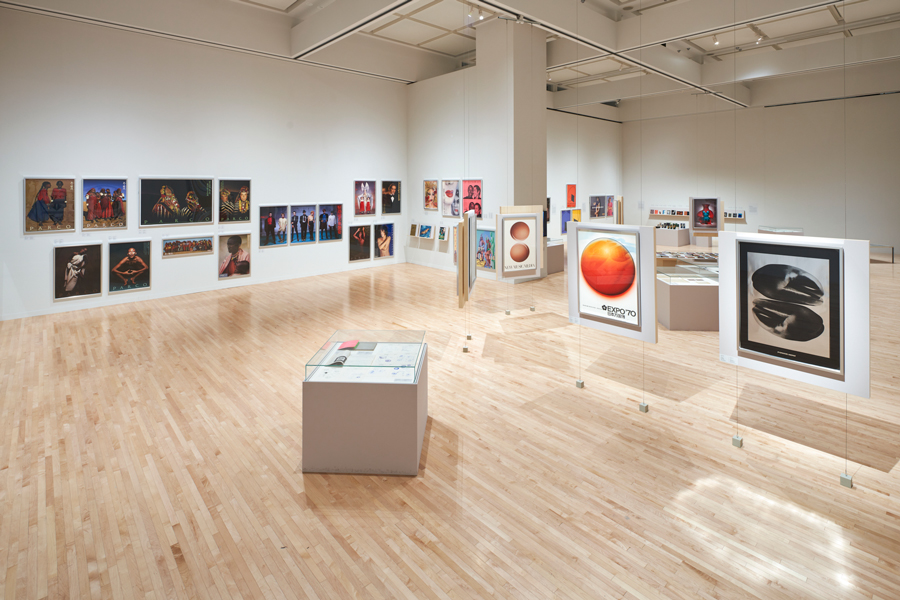
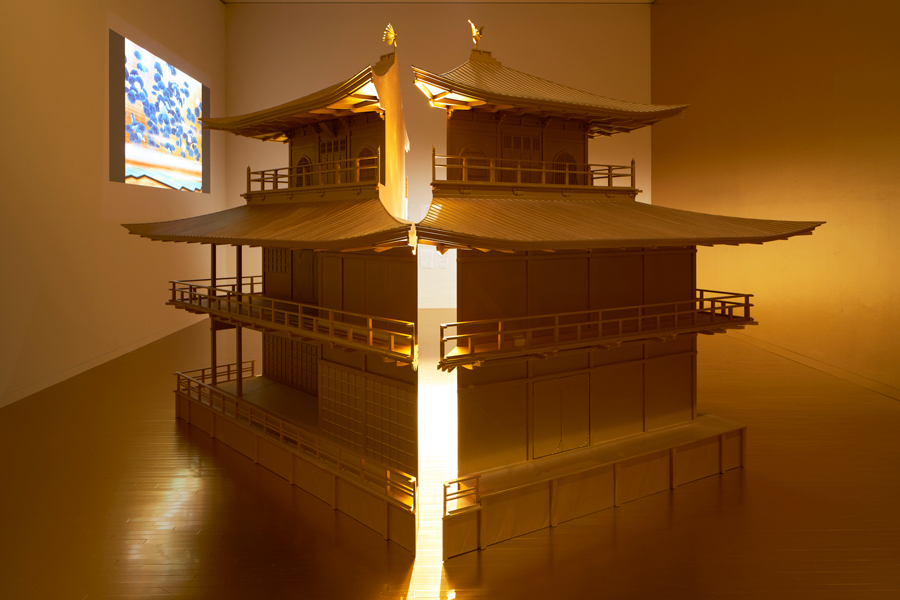
“Eiko Ishioka: Blood, Sweat and Tears-A Life of Design”exhibition view, Museum of Contemporary Art Tokyo (2020-21) Exhibition featuring graphic works (left) and a recreation of the set from the film “MISHIMA”. Photographer: Kenji Morita.
Ishioka The costumes for the film ’Dracula’ were Eiko's first job abroad and were an important work that won her an Academy Award. Among other things, the 'red armour', 'red dressing gown', 'white wedding dress' and 'Klimt-style gold gown' were essential. Because I considered the four costumes to be important elements representing the story and characters of the film. The director, Mr Coppola, had some of the costumes on display at his Napa Valley winery, so we negotiated to rent them out, but it didn't go anywhere.
When I couldn't give up, I found the creator of the red dressing gown and she said she would be happy to make it if I could find a pattern. However, it was 30 years ago and I couldn't find a pattern. At that time, my friend and fashion creator Sachiko Ito, who worked with Eiko at Parco, advised me that she could imagine and create it from a photograph. As a result, the re-production was realised. Incidentally, the inner white dress was made by Ms Ito.
ー An exhibition was also held at the ggg at about the same time.
Ishioka It seems that for a long time, Eiko and Eishi Kitazawa of the ggg had been talking about the exhibition. However, my sister passed away and I decided to take over. However, I wanted to open an exhibition of Eiko's full works first, so I told him that the ggg did not have enough space for it. Even so, he said he would like to realise the exhibition at the ggg in some way. In the end, because of the Coronavirus Disaster, the MOT exhibition and the ggg exhibition overlapped. The MOT exhibition was a full works exhibition and the ggg exhibition was a graphic exhibition, so naturally we were able to separate the two and create exhibitions with different personalities.
ー The background audio in both exhibitions was Ishioka's voice, which helped us understand the concept of 'Timeless, Original, Revolutionary' that underlies her creations. I think that what Ryoko said at the beginning, "one trunk named Eiko Ishioka", was expressed beautifully.
Ishioka That sound recording was an interview that Mr Kitazawa had prepared, with the other party being Koichi Kawajiri, the author of ” EIKO ISHIOKA:A JOURNEY TO FIND NEVER SEEN BEFORE”.
Eiko had slipped out of the hospital for the interview. So the talk was about design in general, as if it were a testament. When I heard the tape, I thought it was important material to prove that Eiko's creations in Japan and America were connected by a single stem. I begged Kitazawa to let me use it in the MOT exhibition, and thanks to his willingness to do so, I was able to play it as background music for the two exhibitions.
Eiko Ishioka's 50-year-long 'Creative Theatre' consists of two main acts. The first act is set in Japan, where she plays the role of designer and art director. After graduating from Tokyo University of the Arts, she joined Shiseido's advertising department, where she broke into the male-dominated design world of the time. For example, she created bold posters showing the mainstay product Honey Cake cut in half with a kitchen knife, and cosmetic foundation posters featuring Bibari Maeda(see “Shiseido Corporate Museum” on the this website.)to renew the image of women. These designs by Ishioka were the driving force behind updating Shiseido's image. After becoming independent from Shiseido, she worked on the total direction of Shibuya Parco and a series of communication designs on a freelance basis. To create image of Parco, she used Academy Award-winning actress Faye Dunaway as an icon of the era, Kenji Sawada as a symbol of hermaphroditism, female nudity and ordinary people living on the frontier, which became a major talking point. With her unconventional and provocative expression, she cut out and visually reconstructed the peculiar era of the 1970s. It is precisely this "underlying my work and my way of life has always been a passion to keep progressing. Because in my generation it was hard for women to keep working. That is why I have acted" (AERA DESIGN), which is also Ishioka's way of life.
Her second act is set in New York and all over the world, where her role is that of creative director and production designer for film and theatre. There, she took on a new form of expression in the show business world of film, theatre and opera and working with artists. She made the leap from the two-dimensional world of graphic design to the three-dimensional world of creative direction, from costume to space.
Act II collaborators include Francis Ford Coppola (Japanese poster for the film Apocalypse Now), jazz king Miles Davis (record jackets), film directors Paul Schrader and Tarsem Singh (creative direction of the film), artist Björk (video production) and countless others. It is not impossible to ask Ishioka directly how she managed to play the role of creative director against such greats.
However, there must be a strong trunk running through the foundation of her creativity. We would like to write her message from the afterword of Ishioka's book "I DESIGN" that provides a clue to this.
In what way do you store up nourishment for creation?
'One thing I can tell you is that I must keep my five physical senses (now including the six senses) sharpened, and for 24 hours, that is from the beginning of the day to the end, what I see, hear, feel, touch, etc. are stored in my body. And when it comes to the stage of acting, the absorbed essence is awakened and agitated, and it gives commands to the brain.
How have you been able to overcome so many crises and come this far?
For me, none of the projects would have seen the light of day without the help of the people who crossed national boundaries, race, gender, scrambled with each other as independent human beings and shared their loneliness, beauty, laughter, anger, sorrow and so on. The Emotion that I have developed through my relationships with them is my best, and only, guide to expression.
Art and Design
ー I saw both exhibitions, and was impressed by Eiko's design background, which was conveyed through her sketches, proofs, competition entries and croquis from her time at art college at the ggg exhibition.
Ishioka My sister is the one with the anecdote that she brought her croquis to the Shiseido entrance examinations, whereas others brought their design work. This was because she was convinced that this was the starting point of expression. Similarly, whenever she started a new work, she always began with a blank canvas, so the process was laconic. The ggg exhibition project was ultimately about showing Eiko's work and the design process behind it, including sketches and proofs.
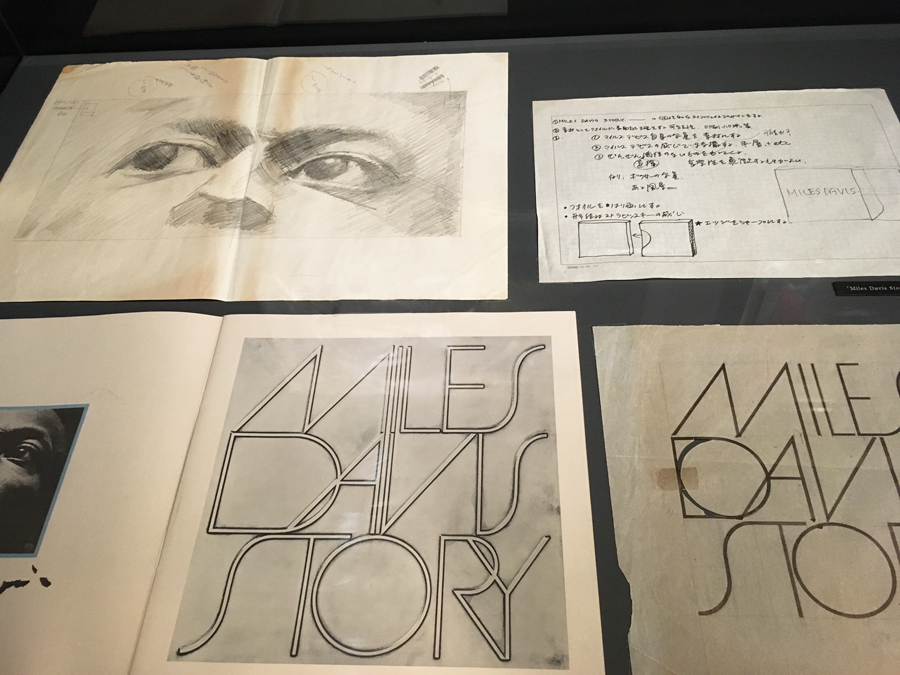
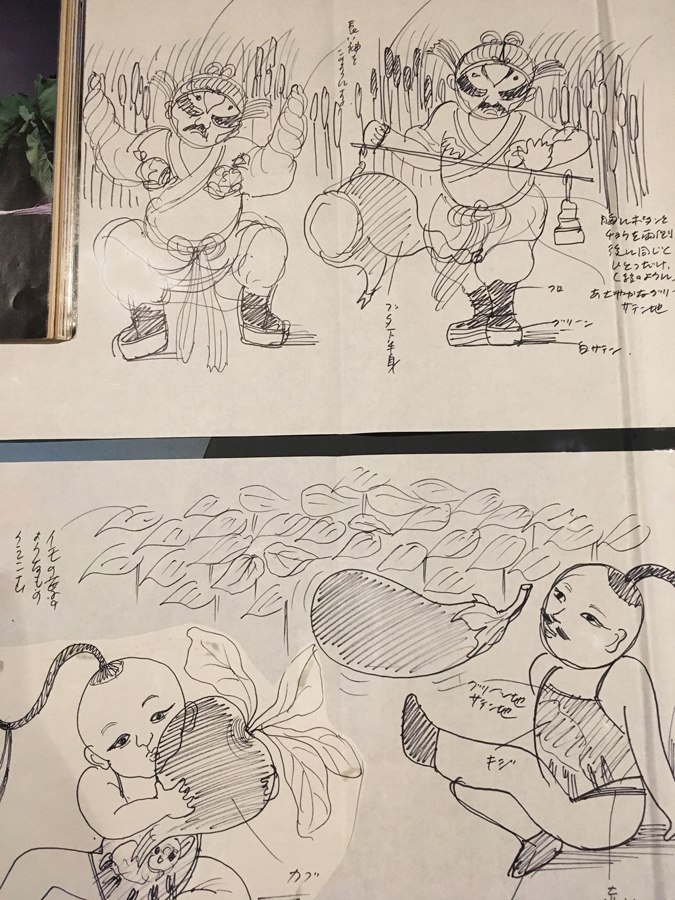
The croquis and proof papers exhibited at the kyoto ddd exhibition and ggg exhibition, reveal outstanding expressive power and imagination.
ー The two exhibitions have different approaches: the MOT is contemporary art and the ggg is graphic design. What did you feel about this through the exhibitions?
Ishioka In the design world, it is important how the concept of an exhibition is embodied, so at the ggg we focused on that part of the exhibition. I realised that art curation and design direction have a different sense of purpose.
For example, in the composition of an exhibition, I would not allocate the venue space evenly, but would consider the theme of 'can blood, sweat and tears be designed'. To achieve this, I would read and understand the overall flow of the exhibition, and if it is more effective to use a stronger or weaker design, I would choose that option. We also try to make it feel as emotional as possible. In art, however, I felt that it is important to "convey the message correctly" in a restrained manner.
Since art museums are derived from museums, it is understandable why they say that they "reflect the period while unravelling its history, and focus on chronology". So I could agree that Eiko's advertising work in Japan could be displayed in chronological order. But after moving to the US, her various projects occurred simultaneously. I believed that the exhibition of her work after the US would better convey the overall spirit of Eiko Ishioka if it was not presented in chronological order.
ー I felt the same way when I read Ms Ishioka's own book, “I DESIGN”.
Ishioka She had established herself as an art director in Japan. But in the US, she had to start by establishing her position on a project-by-project basis. She said: 'My work in the US consisted of design commissions for costumes, sets or products, or both. So I was not satisfied with the title of costume designer. I designed for the whole film or stage, so I was designing for the whole film or stage. ......".
ー It's true that Ishioka’s imagination is so strong that it goes beyond the scope of costume design and has a great influence on the world of film and theatre.
Ishioka My sister said that films and stages ultimately belong to the director. However, as long as I was involved as a member, I understood the director's overall intentions and thoroughly discussed what I wanted to create, which was my sister's consistent attitude.
ー On the other hand, the ggg focused on graphic work and closely followed designer Eiko Ishioka. In particular, the exhibits, such as sketches and proof sheets, seemed to convey Ms Ishioka's body heat.
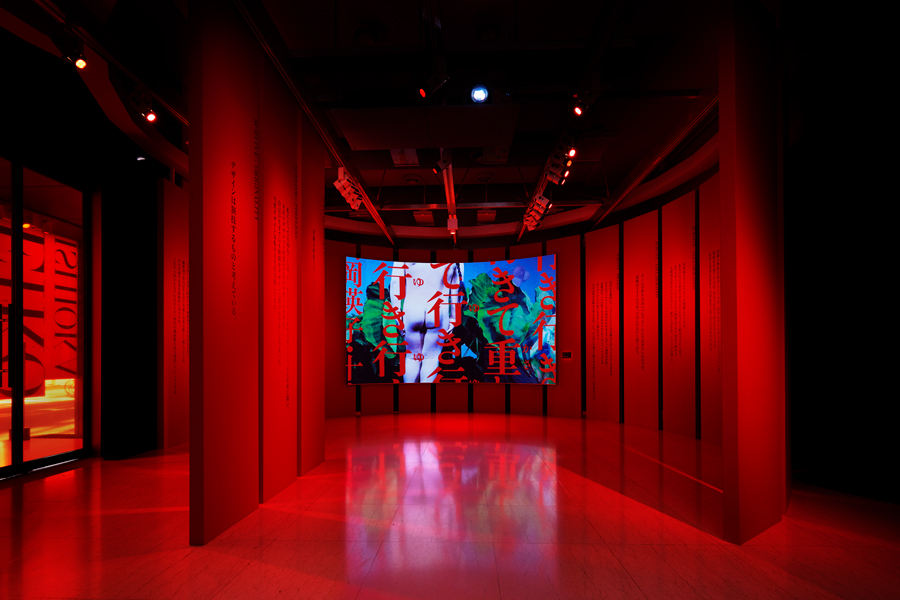
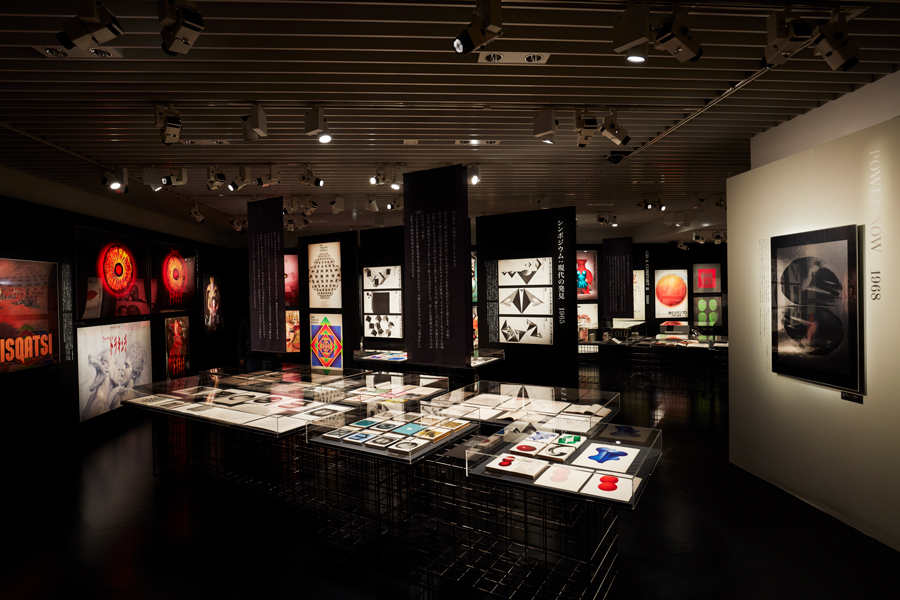
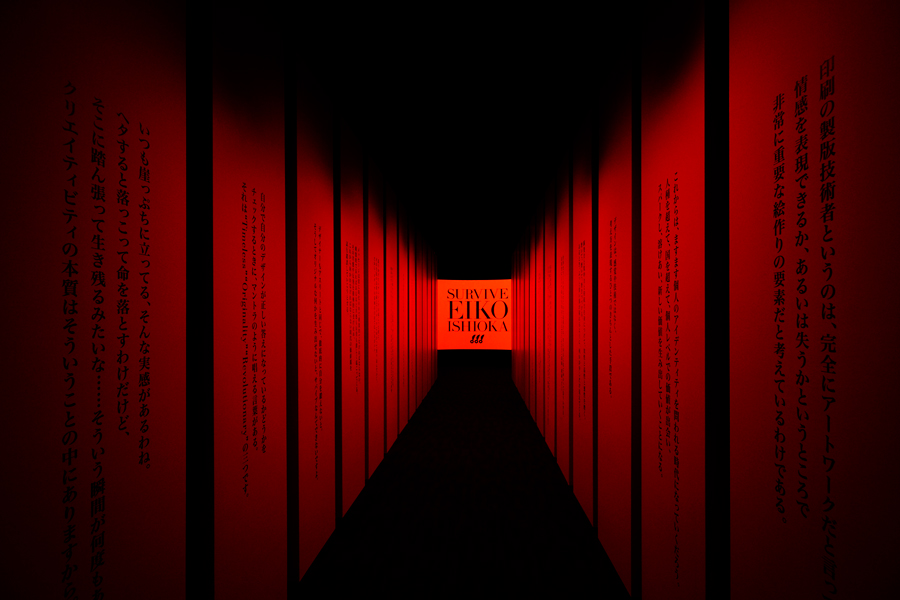

View of the ggg exhibition venue in Ginza, Tokyo. At the entrance, Eiko's words were displayed in a space of deep red, Ishioka's symbolic colour,
View of the ddd exhibition venue in Kyoto. The exhibition begins with a crimson corridor filled with words.
Photographer: Shinichi Kaneko
Ishioka At the ggg, where only graphic work was exhibited, each piece was examined individually before deciding which works to exhibit. Only after organising and viewing all of my sister's works and materials did I realise that this was important, that it had meaning, etc. When Taku Satoh, who participated in the planning of the MOT exhibition, asked me, "Are you going to do a retrospective this time?" to which I replied, "Of course I'm going to do it as a living person”. My sister's work is timeless, which is why we are having the exhibition now. In that sense, it was very important to play the direct compositions, sketches and voice overs that conveyed her own breathing and body temperature.
ー Will such valuable materials continue to exist in Japan?
Ishioka Much of her work in Japan basically remains in Japan. Happily, an exhibition expanding on the ggg exhibition will start touring in autumn 2023, starting with the Kitakyushu Municipal Museum of Art. The archive clearance will continue afterwards.
Nevertheless, I am worried about what will happen to these objects after my death. I have two nieces, both of whom live abroad. Under these circumstances, I wanted to make sure that only the posters were left anyway, so I have put together all of my sister's poster works into five sets and donated one to the DNP Foundation for Cultural Promotion. We are now researching where to donate the remaining four sets. There are several museums and universities that have come forward, but at the moment I am refusing to accept those that only want a couple of representative works. The reason why I insist on collecting all the works is that the value and meaning of representative works can be revealed when the collection is large enough to show the flow of the artist's thoughts.
ー At the MOT and the ggg exhibitions, young people were eagerly looking at Ms Ishioka's work. Even though we live in a digital age, the impact of the actual object cannot be received digitally.
Ishioka Eiko's works are mostly in printed matter, but there is a complete difference between confronting the actual work and seeing it on a website. I was happy to hear that many people who saw the exhibition said it was burned into their brains and etched in their hearts. A friend of mine told me that when she took her primary school son to the exhibition, he stopped moving in front of the posters even though he wasn't interested in art.
About the Japanese design archive
ー Do you have any feelings about design archives?
Ishioka In graphic design, posters can be preserved relatively well, but it is still difficult to say whether they can be preserved systematically. It is even more difficult to preserve three-dimensional works such as packaging and paper bags. The current situation of storing only a few representative works must be changed. In the future, the field of expression of graphic designers will expand to include video and the web, so we need to establish a way of being a design archive. I also have a question: what is the goal of this 'Survey on the Actual State of Design Archives in Japan'?
ー First, a survey of 100 people who have contributed to design in pre-war and post-war Japan, and then a report to be published on the web and shared with as many people as possible.
Ishioka Nowadays, people search the web and that's it. The web can be used to record information, but the deep messages, emotions and souls of artworks are drowned out. I fear that if this continues, the most important aspect of human imagination will be lost. We need to create a place where people can come into contact with actual objects in design, just as we do with art.
ー That's right. There is now momentum for the creation of design museums in various parts of Japan, and we would like to find ways to collaborate with such organisations. However, I feel that there are parts of the conventional concept of a museum that do not understand how design should be handled.
Ishioka I am not comfortable with judging whether ‘design’ has value or not by the same standards as art. I also don't like the idea that the value of design is determined by conventional museum concepts. In the first place, 'design' and 'art' are two different things. I think it's about time we had a viewpoint that evaluates design based on its own concept.
Design has a short history, but the message of design has a sense of time, its creativity has a philosophy. The act of embedding excellence and soul is the same in design and art. I think design is adjacent to art.
To begin with, in the modern era of radical change, where the fundamentals of communication are being shaken by the evolution of technology, it is not right to define design in terms of concepts from the past. I think the time has come for museums to free themselves from the traditional framework. Museums are now being asked how they will create a new culture, crossing genres such as film, theatre, music, fashion, manga and animation, as well as design. I think it is very meaningful to have design museums for the development of design, but I hope that each museum will focus on creating a history of design in pursuit of 'quality'.
ー Thank you very much for your time today.
Interview 2
Date: 19 November 2021, 16:00-17:30
18 April 2023 16:00-17:30
Location: DNP Foundation for Cultural Promotion
Interviewee: Eishi Kitazawa, Takako Morizaki, Aya Tanaka
Interviewer: Keiko Kubota, Yasuko Seki
Author: Yasuko Seki
DNP Foundation for Cultural Promotion and Eiko Ishioka
Currently, Eiko Ishioka's works and materials are preserved mainly in Japan and the USA.
Many of Ishioka's works and materials, which were donated to two US organisations (the Academy of Motion Picture Arts and Sciences and the University of California, Los Angeles) about 10 years ago, have been archived and are available on the web. This is in contrast to the actual situation in Japan.
Most of what is currently in Japan is kept by her sister, Ryoko Ishioka, but their future has not yet been determined. So, with the help of the DNP Foundation for Cultural Promotion (hereafter DNPF), Ryoko compiled all of Eiko Ishioka's posters into five sets and donated one of the sets to the DNPF. It was a desperate measure to at least keep the posters.
Here, we spoke to Eishi Kitazawa (who retired in April 2023), who has been involved in DNPF's activities for many years and has led exhibition and publication activities through his friendship with many graphic designers and art directors, from the masters to the young, about Eiko Ishioka's archive and the exhibition held at the ginza graphic gallery (hereafter ggg). Colleagues Takako Morizaki and Aya Tanaka also took part in the interview.
Archives dispersed in Japan and the US
The history of the Eiko Ishioka Poster Collection
Kitazawa In early autumn 2011, I was supposed to discuss the donation of posters and the holding of an exhibition with Ms Eiko Ishioka, who was returning home from the USA, together with an editor, Koichi Kawajiri, but we suddenly had to cancel the meeting due to her poor health and lost contact with her. A short time later, at the beginning of 2012, we were shocked to learn of Ms Ishioka's death. The task was then taken over by her own sister, Ryoko. However, after discussions between Ryoko and Eiko's husband, film producer Nico Soultanakis, it was decided that many of Eiko Ishioka's films and materials would be sent to the USA.
Morizaki Meanwhile, Ryoko, Kitazawa and I visited the warehouse several times between July and August 2014 to conduct research, after which we compiled all 476 posters into five sets. One of those sets is in the DNPF archive as a collection.
Kitazawa The DNPF has a collection of about 20,000 works by about 200 artists from Japan and abroad, centered on the Ikko Tanaka Archive, the Shigeo Fukuda Archive, the Kazumasa Nagai Archive and the Tadanori Yokoo Archive. The other four sets are owned by Ms Ryoko Ishioka. As for the other four sets, Ryoko is investigating suitable donation recipients.
About the Eiko Ishioka exhibition
Kitazawa I had been consulting with Eiko Ishioka about holding an exhibition at the ggg since around the time of the production of "ggg Books-68 Eiko Ishioka", the world graphic design series published by the ggg (2004-2005). Then, in 2011, I set up an interview of Eiko Ishioka for the foreword to the foundation's activity report, Graphic Art and Design Annual 2010-2011, on the theme 'Can graphic design survive?’ The interview was conducted in New York by Koichi Kawajiri, who was acquainted Eiko, just three months after the Great East Japan Earthquake. Then, in 2020, at the same time as Ms Ishioka's full-length exhibition at the Museum of Contemporary Art Tokyo (hereafter MOT), the ggg held an exhibition focusing on her graphic work entitled 'Eiko Ishioka: Can Graphic Design Survive?’ The exhibition was foreshadowed by a long interview in 2011.
The main works on display are posters, sketches and prints from her work from the 1960s to the 1980s, particularly for Shiseido and Parco. Other works, such as ”Yasei-Jidai (Wild Times)” (Kadokawa Shoten), book bindings, illustrations, lithographs, competition entries and graduation works, got to the heart of Eiko Ishioka's creativity. We also played the voice of Eiko Ishioka in an interview in the exhibition space, in order to create a sense of the humanity and presence of this creator.
Her works were, for example, proof sheets for Miles Davis record jackets, in which Eiko's handwriting has no hesitation, and the precise instructions and changes she wrote in them show her passion for design and her outstanding skills. Directing humanity of her was a long interview of risking her life that Eiko left the hospital to give, which was edited and played at the exhibition. The effect was as if Eiko was speaking to the audience. However, her powerful life lessons have become a testament to young designers.
Also, by drawing a line between the themes of art at the MOT and design at the ggg, we were able to express the versatility and excellence of Eiko Ishioka as a graphic designer, art director, creative director and costume designer through both exhibitions. At the same time, it could be shown that Eiko's pre-80s work shown at the ggg became a foothold for her to expand abroad.
This exhibition was realised in good shape thanks to Ryoko, her own sister, who took the lead from the early stages. Eiko and Ryoko were leading the design world as rivals as art directors and designers. However, they were never conscious of each other because they were sisters, apparently. However, upon Eiko's death, Ryoko is confronted with her own sister Eiko's vast body of work, which she is left with, and gradually becomes aware of Eiko's greatness. The sisters almost never had the opportunity to work together before her death, but this exhibition may have been the first time they worked together.
The ggg exhibition goes on tour
Tanaka The exhibitions at the ggg and kyoto ddd gallery were very well received. It coincided exactly with the time of the Corona disaster, and the title of the exhibition, "Can Graphic Design Survive?" led to sympathy. In addition, Eiko Ishioka's flesh-and-blood voice, which was played to the audience, particularly resonated with young women, some of whom took note of every single word at the exhibition.
The exhibition will tour to several museums across Japan from this September, starting with the Kitakyushu Municipal Museum of Art. Like the ggg and the kyoto ddd gallery, the exhibition's contents will focus on Eiko's work from the 1960s to the 1980s, and will also include advertising work, book design, artwork, record jacket design and hand-drawn sketches - over 400 pieces in all. At the same time, her words will be scattered throughout the venue, treating them equally with her artwork.
Statue of Eiko Ishioka by Eishi Kitazawa
Kitazawa To tell the truth, I have stored all the faxes, mails and colour proof sheets that I received from Eiko. Her letters and writings are as dynamic and beautiful as her appearance, and her instructions are precise, and it is obvious at a glance that she is clear-headed and sensitive. She is, above all, tenacious and thoughtful about even the smallest creative act, and will not allow any compromise until she is satisfied with her work. In addition to this, Eiko's persuasive, unique, deep magic voice and generous receptiveness naturally attract everyone to her enthusiasm. In a word, it was like watching a miracle of spontaneity, concentration and persistence.
Eiko tackled design and creation head-on at all times. She always said, "The most important thing for an expressive person is discipline". In other words, working with leading people and doing leading work meant refining and nurturing oneself. On the other hand, many people did not think well of her because she was more determined than others to do the best work and was a good self-producer. However, it seems that two masters of Japanese graphic design, Yusaku Kamekura and Ikko Tanaka, recognised her talent and developed a close friendship with her. Even today, there is a 'glass ceiling' in the design world and it is very difficult for women to be active, but the hurdles must have been much higher in Eiko's time than they are now. I think it was no mean feat for her to do that much work, both in terms of mass and quantity.
In these difficult times for women, the only person who had an influence on Eiko was Leni Riefenstahl (1902-2003), who directed the excellent propaganda film Olympia under the Nazi regime. Although there is still a lot of controversy around the world about Leni, I would say that what Eiko and Leni had in common was a "passion for creation".
As an aside, I am looking forward to the emergence of a second Eiko Ishioka, a genius with such passion and talent, in the Japanese design world today.
What do you feel about design archives?
Kitazawa Design archives are a common concern worldwide: Alliance Graphique Internationale (AGI), established in 1952, is also moving to set up a fund for archives, but it will take a long time before it materialises. It is unfortunate that the archives of international designers such as Eiko Ishioka are being lost overseas, but this is unavoidable given the current situation in Japan.
The DNPF is also implementing the DNP Graphic Design Archive, but it is also true that there are limits to what one foundation can do. What is important is to collect works in the spirit of the 'no limits, no purpose, no plan' of one museum, with a view to 100 years from now. Archiving is about not judging usefulness by current standards.
September 9 - November 12, 2023
"Eiko Ishioka I Design" exhibition at Kitakyushu Municipal Museum of Art
https://kmma.jp/exhibition/
Eiko Ishioka's archive
Enquiries to.
DNP Cultural Promotion Foundation (regarding the poster archive)
https://dnpfcp.jp/foundation/

